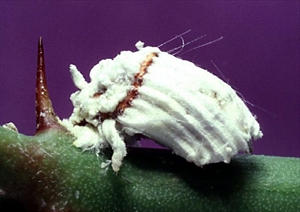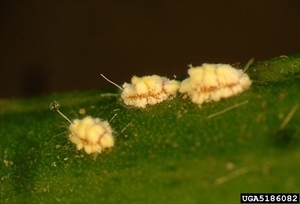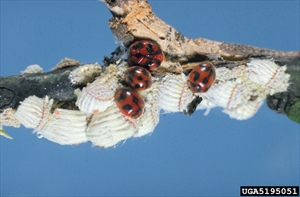Citrus fluted scale, cottony cushion scale,
Pacific Pests, Pathogens, Weeds & Pesticides - Online edition
Pacific Pests, Pathogens, Weeds & Pesticides
Citrus fluted scale (343)
Icerya purchasi
Asia, Africa, North, South and Central America, the Caribbean, Europe, Oceania. It is recorded from Australia, Fiji1, French Polynesia, Guam, Kiribati, Marshall Islands, Federated States of Micronesia, New Caledonia, New Zealand, Northern Mariana Islands, Palau, Papua New Guinea, Solomon Islands, and Tonga.
Wide host range of, mostly, woody plants. It is common in plants in the following families: casuarina, citrus, guava, legumes (pigeon pea, lucerne, wattles, winged bean), mango, mimosa, rose, and many more. Many ornamentals (begonia, camellia, fuchsia, hydrangea), and weeds are also hosts.
The scale, adults and nymphs, sucks sap and weaken plants. Stems dry up, leaves wilt, fall, and branches dieback. Honeydew is produced and this falls onto foliage and flowers and, in turn, becomes colonised by sooty mould fungi, turns black, and blocks sunlight. Excessive amounts of blackened leaves reduce the growth of plants.
The adults are yellowish or white, covered with wax, up to 10-15 mm long (Photo 1). Beneath, their bodies are bright orange-red, yellow or brown. Often, they occur in large groups (Photo 2). The fluted part is the egg sac, which is more than twice the length of the body.
The females are hermaphrodites, that is, they produce both eggs and sperm. Interestingly, they can fertilise themselves. The fertilised eggs are kept in the egg sac and when they hatch 'crawlers' emerge; these are bright-red, and mobile as the name suggests (Photo 3). After a short while, the crawlers settle to feed and moult (Photos 4&5). Occasionally, winged males are produced from unfertilised eggs, and they mate with the hermaphrodite 'females'.
Spread occurs when crawlers disperse over short distances, or longer when carried by wind currents, vehicles, animals, birds, or on clothing. All stages are spread in the horticultural trade of plants or plant parts. Older nymph stages also move a little after they moult as, unlike most scales, they have legs. They move from shoots to twigs, to branches and trunks.
Although Icerya purchasi feeds on a large number of shrubs and trees, it is especially common on citrus, Acacia (wattles), Casuarina (she oak) and Pittosporium (cheesewoods). The devastation on citrus in California (see under Natural Enemies) and, later, in other countries when the scale was accidently introduced, shows how important this scale can be when not under biological control.
Look for the adults and late stage nymph in groups, along the veins of leaves, especially on the undersides. Look for ants and sooty moulds on the leaves as they are often very noticeable, and indicate that scale insects are present.
NATURAL ENEMIES
The control of Icerya purchasi on citrus in California at the end of the 19th century by the ladybird beetle, Rodolia cardinalis, was one of the first successes of biological control (Photo 6). Another natural control, the fly, Cryptochaetum iceryae, has also been used.
The management of Icerya purchasi is based on biological control, and rarely on the use of insecticides. The exception being the use of insecticides against ants (see under Chemical Control). Ants often visit colonies of the scale for their honeydew. In the process, they defend the scale from predators.
CULTURAL CONTROL
- Check that nursery stock is free from scale; if present, prune infested parts, and spray with insecticides (see below).
- Ensure the citrus trees are well cared for with adequate nutrition.
CHEMICAL CONTROL
Crawlers are more susceptible to insecticides than other stages, but they very small and difficult to see. There are also overlapping generations, so adults are always present, and this means that several applications of chemicals are necessary to obtain control. And adults are difficult to kill because of their protective scales. (Note dimethoate, once recommended in Pacific island countries, is under suspension in Australia for use on many crops.)
- Use white oil (made from vegetable oils), soap solution, or horticultural oil (made from petroleum) (see Fact Sheet no. 56). Often the damage occurs in patches on the trees, so consider just spot-spraying those areas where infestations occur, rather than the whole tree.
-
White oil:
- 3 tablespoons (1/3 cup) cooking oil in 4 litres water.
- ½ teaspoon pure handsoap, not detergent
- Shake well and use.
- Soap:
- Use soap (pure soap, not detergent):
- 5 tablespoons of soap in 4 litres water.
-
- Commercial horticultural oil can also be used. White oil, soap and horticultural oil sprays work by blocking the breathing holes of insects causing suffocation and death. Spray the undersides of leaves; the oils must contact the insects. A second application of soap or oils may be necessary after 3-4 weeks.
- The addition of malathion is useful against scales insects, but it is likely to kill natural enemies. Malathion should be avoided, if possible.
- Synthetic pyrethroid insecticides are likely to be effective against the crawlers - crawlers are the active nymphs that spread infestations, but they are difficult to see as they are so small. Synthetic pyrethroids are likely to kill natural enemies. They should be avoided, if possible. But may be useful against colonies of ants, especially if the ant species is ground nesting.
____________________
When using a pesticide, always wear protective clothing and follow the instructions on the product label, such as dosage, timing of application, and pre-harvest interval. Recommendations will vary with the crop and system of cultivation. Expert advice on the most appropriate pesticides to use should always be sought from local agricultural authorities.
AUTHOR Grahame Jackson
1Information from Swaine G (1971) Agricultural Zoology in Fiji. Her Majesty's Stationery Office. London; and CABI (2016) Icerya purchasi (cottony cushion scale). Crop Protection Compendium. (https://www.cabi.org/cpc/datasheet/28432); and Icerya purchasi. Wikipedia. (https://en.wikipedia.org/wiki/Icerya_purchasi); and Icerya purchasi Maskell. Featured Creatures, Entomology & Nematology. UF/IFAS, University of Florida. (http://entnemdept.ufl.edu/creatures/fruit/cottony_cushion_scale.htm); and from Weeks JA (2012) Citrus Pests Cottony cushion scale Icerya purchasi (Hemiptera: Margarodidae). USDA, University of Florida. (https://idtools.org/id/citrus/pests/factsheet.php?name=Cottony+cushion+scale); Photos 1&5 Jeffrey W. Lotz, Florida Department of Agriculture and Consumer Services, Bugwood.org. Photo 2 Lesley Ingram, Bugwood.org. Photo 3 Lorraine Graney, Bartlett Tree Experts, Bugwood.org. Photo 4 Sonya Broughton, Department of Agriculture & Food Western Australia, Bugwood.org.
Produced with support from the Australian Centre for International Agricultural Research under project PC/2010/090: Strengthening integrated crop management research in the Pacific Islands in support of sustainable intensification of high-value crop production, implemented by the University of Queensland and the Secretariat of the Pacific Community.









